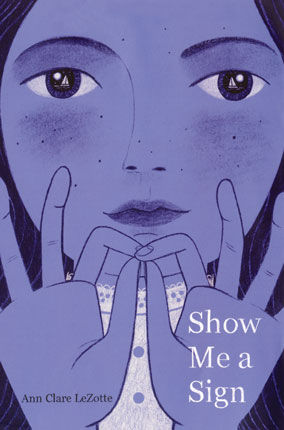| Show me a sign Author: LeZotte, Ann Clare | ||
| Price: $6.50 | ||
Summary:
It is 1805, and Mary Lambert has always felt safe among the deaf community of Chilmark on Martha's Vineyard where practically everyone communicates in a shared sign language, but recent events have shattered her life; her brother George has died, land disputes between English settlers and the Wampanoag people are becoming increasingly bitter, and a "scientist" determined to discover the origins of the islands' deafness has decided she makes the perfect "live specimen"--and kidnapped her.![]() Download a Teacher's Guide
Download a Teacher's Guide
Video Preview:
| Accelerated Reader Information: Interest Level: MG Reading Level: 5.10 Points: 7.0 Quiz: 506689 |
Reviews:
Kirkus Reviews (+) (11/15/19)
School Library Journal (+) (03/01/20)
Booklist (02/01/20)
The Bulletin of the Center for Children's Books (A) (00/03/20)
The Hornbook (00/09/20)
Full Text Reviews:
Booklist - 02/01/2020 Mary Lambert, 11, narrates this story, set in the early nineteenth century, about Chilmark, a community on Martha’s Vineyard. One in four residents are deaf, and everyone speaks Martha’s Vineyard Sign Language (MVSL). Into this community comes Andrew Noble, a young Boston scientist who wants to study the Deaf population in order to pinpoint an external cause for the deafness. He is arrogant and condescending, and he manages to offend almost everyone. Dissatisfied with his research, Andrew kidnaps Mary and takes her to Boston as a “live specimen.” Although subjected to horrible treatment, Mary makes her way home. LeZotte’s portrayal of Mary is precise and thoughtful, as the girl absorbs and analyzes everything she experiences. LeZotte’s depiction of language is striking—the reader sees the difference in conversations in spoken English and MVSL—and she thoughtfully addresses tensions among the white, Black, and Wampanoag people who share the island. LeZotte, who is Deaf, makes the point that nothing should stand in the way of building community and seeking equality, a sentiment that resonates today. Though, like today, there are still no easy answers. - Copyright 2020 Booklist.
School Library Journal - 03/01/2020 Gr 3–7—Free-spirited, inquisitive 11-year-old Mary Lambert loves to spin stories. She's also deaf, as are her father and many others on Martha's Vineyard. No one knows why the island has such a high population of deaf people. Mary's friend Ezra Brewer, the old seaman, says that deafness is in the blood and was brought to the island when the original Lamberts settled there more than 100 years ago, in 1692. Signing is the only language Mary has ever known, and her life is full. But when tragedy strikes her family, she keeps a deep secret from her parents; she knows it is all her fault. Her relationship with her mother becomes strained, and everyone is on edge. Learning that a scientist is coming to the island to study why there are so many deaf residents sparks Mary's curiosity. He charms her mother and many others on the island, but Mary soon discovers his intentions are not honest while falling victim to his deceitful plan. She is taken from her home and becomes his "live specimen" for scientific study. Her struggle to regain control of her life in a world where the deaf are considered "moronic" and her determination to find a way home will take all of her strength, cunning, and courage. LeZotte crafts a moving tale of 1805 Martha's Vineyard that highlights issues still relevant more than 200 years later, including racism, ableism, and prejudice. Colonialism of the Wampanoag land as well as a perception of savagery among the Indigenous people, the preconceptions of the deaf, and a family's attempt at overcoming tragedy while remaining whole are the underlying themes in the novel. But these themes add nuance to the expertly crafted story of Mary, her response to her situations, her courage, and her hope that she will reunite with the community she loves. VERDICT Exceptionally written, faced paced, and full of topics that will inspire deep discussion. A valuable addition to secondary elementary or middle school collections.—Carol Connor, Cincinnati Public Schools - Copyright 2020 Publishers Weekly, Library Journal and/or School Library Journal used with permission.



